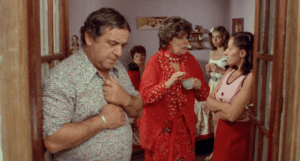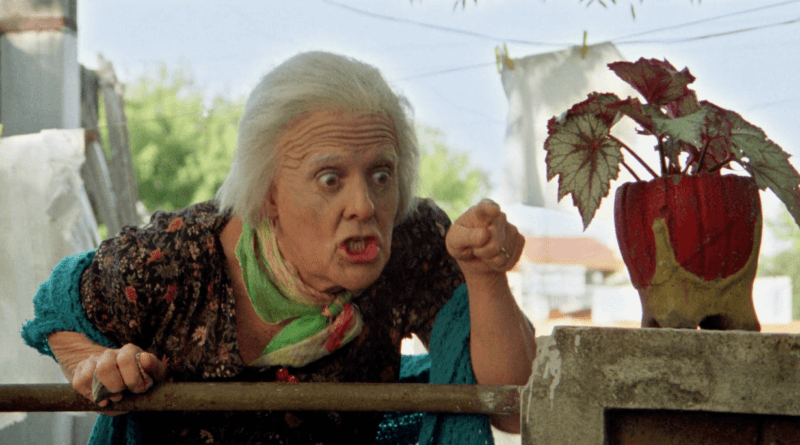Review: Waiting for the Hearse (Esperando la Carroza, 1985) ★★★
Films that are based on plays, or are produced by those who have spent years in theatre, are often readily identifiable, for better or worse. Staging is frequently put at the forefront, with careful attention dedicated to the placement of the actors within each scene. We also see longer takes and slower pacing, and each scene is riddled with fast, often biting dialogue to make up for the lack of action. Such is the case with Esperando La Carroza or “Waiting for the Hearse,” a somewhat strange and over-the-top comedy from Argentina, featuring actors whose names are well known in Argentina’s theatrical world. The script is based on a play of the same name by Uruguayan playwright, Jacobo Langsner. The director, Alejandro Doria, started his career in television, directing Argentine variety shows in the 1960s before eventually transitioning to film. The three different spheres of entertainment involved (film, television, and theatre) are somewhat awkwardly blended in this bizarre comedy. It is a modern entry in the grotesco criollo, a theatrical subgenre specific to Buenos Aires, but with roots in Italian theatre. These works focus on characters that have a delusional self-image, and the comedy often arises when they are forced to see reality, and their delusions are exposed for ridicule.
Waiting for the Hearse follows an Argentine family, rife with infighting, as they try to deal with the aged matriarch of the family, affectionately known as “Mama Cora.” Mama Cora, played by famed Argentine comedian and impersonator, Antonio Gasalla, is a nuisance to her four children and their respective spouses. She is forgetful, stubborn, and insists on helping (or meddling) in every situation. At the start of the film, her daughter-in-law, Susana, has a nervous breakdown from dealing with Mama Cora (who has been living with them for several years) and insists on meeting with the other siblings in the hopes that they will take Mama Cora off her hands. None of the children want anything to do with the old woman’s care, though they all (with the exception of Susana) profess great affection and admiration for her.
As the story progresses, the somewhat eccentric and absent-minded old woman goes off on her own, leaving the children to bicker amongst themselves. Once they realize she is nowhere to be found, they search desperately for her, even going as far as to report her missing to the police. The tension amongst the hot-blooded siblings rises, leading to even more fighting and increasingly egregious accusations. When a woman who happens to wear the same shoes as Mama Cora throws herself in front of a train, the family members all blame one another for the old woman’s apparent death.

Waiting for the Hearse feels more like a play than a movie, and this doesn’t always work in its favor. The performances are often excessive, the comedy a little heavy-handed, and nothing on screen comes across as being very natural. This, however, is frequently the case with theatrical comedies, as they are usually far-removed from what we consider to be natural or realistic. It is entertaining to watch the family, many of whom are so unashamedly selfish as to be caricatures rather than real people, fight over every little detail of their lives; from what drinks should be served to which bedroom the wake should be held in, nothing can be done without someone disagreeing or feeling mistreated in some way. This representation of Argentine personalities pushed to the extreme is humorous because it borders on being grating. The personas that they have adopted are so grandiose and delusional that one cannot help but laugh at their absurdity. Easily the funniest of all the characters is, of course, Mama Cora. Antonio Gasalla has perfected his impersonation of crotchety old women from his years working in Argentine television. His characters are often women who are completely oblivious to their surroundings, but nonetheless strong-willed and unafraid to speak their mind. His blank stare and slack-jawed expressions are trademarks of his comedic ability.
Director Alejandro Doria put his years in television to good use, meticulously staging each scene, with the characters speaking their lines with strong, even excessive passion, before swiftly moving to their marks, creating a mosaic of well-crafted mis-en-scene. However this attention to detail often feels strange when set against a script that revels in excess and dark comedy. All of the pieces are there for a great film, but the final product comes across as somewhat cheap and bizarre, though this seems to be intentional. It is certainly a technically proficient film, but the quality of the writing, combined with the peculiarity of the genre itself, make for a somewhat strange viewing experience. However, if for no other reason, Waiting for the Hearse should be viewed for the exemplary and hilarious performance from Antonio Gasalla.
Rating: ★★★ out of 5
Waiting for the Hearse is currently available to stream on Netflix.


Wow dude, you are knowledgeable. That´s way more detailed that I was expecting, especially from a non-Argie. Well done. The movie is a classic in local terms, lots of dialogue is used in everyday life to refer to somebody or something (the crisis: “three empanadas they had” -while eating one- “Dignified misery”; or a dumb person “Ahí lo tenés al pelotudo / There you have it, the dumbass”)